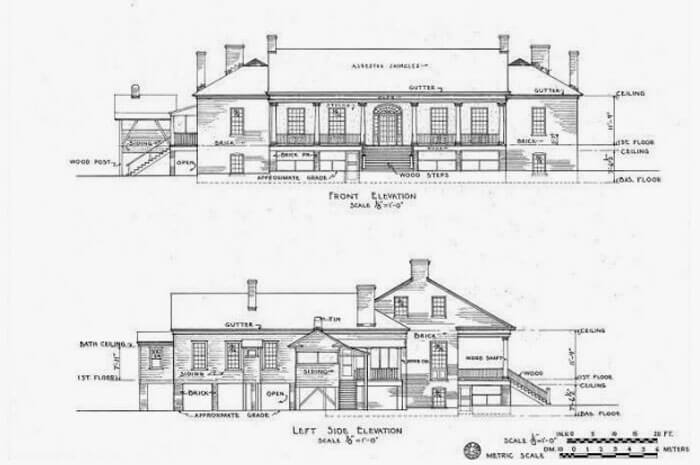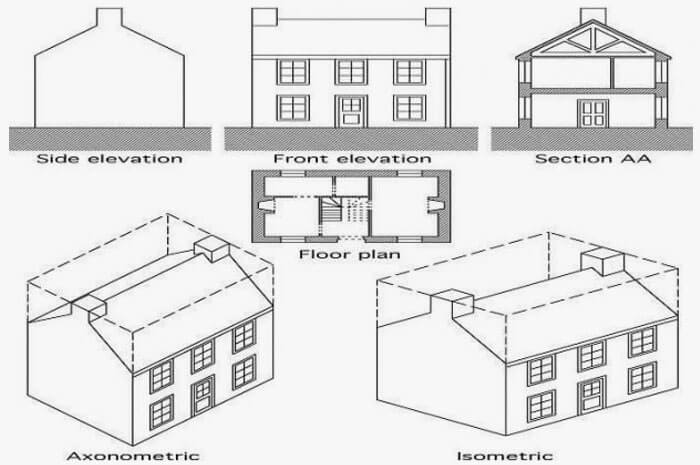Drawing Elevations in Autocad Architecture
What is the Importance of Architectural Elevation Drawings?
This blog has been updated on – March 16, 2022
Architectural elevation drawings play a crucial role in the construction process. But what are they, and how do they help construction and renovation?
Table of Contents:
- Introduction
- What is an elevation drawing?
- Why are architectural elevation drawings an important part of projects?
- Exterior elevation detail drawings
- Interior architectural elevation drawings
- Conclusion
Introduction: Architectural Plans
Before we dive into elevation drawings , we should understand architectural plans.
Architectural plans, also called blueprints, are a comprehensive set of 2D drawings that represent a proposed building project, whether it is a development or redevelopment. In case the structure is meant to be residential, the plans may also be called home plans. Architectural plans typically include all elevation alterations and a list of materials, as well as design notes.
Blueprints are supposed to include:
-
Floor plans
-
Site plans
-
Elevation plans
-
Sections
-
Perspectives (3D)
-
Detail views
Elements in architectural plans include walls, partitions, floors, columns, stairs, windows, doors, door and window call-outs and room designations. These documents work references that stakeholders can refer to for construction projects to:
-
Incorporate new changes
-
Coordinate clearly
-
Understand the project flow
-
Remain updated on the timeline
What are Elevation Drawings?
An elevation drawing , which is part of construction documentation, includes the first angle projection of all the parts of a structure as viewed from a specific direction. The perspective in an elevation drawing is flattened. Most architects use a four-dimensional view when creating the elevation drawing – north, south, east, and west.
According to Designing Buildings, the precise definition of an elevation drawing is: "an orthographic projection of the exterior (or sometimes the interior) faces of a building that is a two-dimensional drawing of the building's façades."
Elevation drawings have to detail:
-
Orientation (north, south, east, west)
-
Building height & wall height measured via natural ground level
-
Each side of the structure at a 1:100 scale
It is important that the level of detail required is specified beforehand. Highly detailed elevation drawings can be expensive and time-consuming to create, while drawings with very few details may not satisfy the client's needs.
Why are Architectural Elevation Drawings a Crucial Part of Renovation Projects?
Architectural elevation drawings are useful for detailed renovations, such as in kitchen designs. Elevation plans enable you to view information that floor plans cannot convey, such as sizes of each drawer, cabinetry details, and each cabinet location.
Elevation drawings are not strictly needed for every redecorating or renovation project, but they are highly useful when designing objects or spaces such as as bathroom vanities, fireplaces, bars or locations with built-in cabinetry, such as entertainment spaces or commercial spaces.
With elevation detail drawings, you can make small changes to the building design before a single brick is laid or item is ordered. This will save you from unpleasant surprises and extra costs during installation.
When properly executed, elevation plans can speed up the approval process and help in construction cost and timeline estimates.
A good contractor or designer will provide you with elevation plans if they are required. However, if they are not provided, we encourage you to ask about architectural elevation drawings, so that it is clear what your finished structure will look like.

Elevation views can be both exterior, such as a of building facade, or interior, such as of a wall in a bathroom. The drawings are shown as a flat plane, but line weights and shading can indicate depth, if appropriate.
Typically, exterior elevations will be of the same scale as the corresponding floor plan. Conversely, interior elevations, which are generally more detailed, might be of a bigger scale.

Exterior Elevations
These are as-built drawings that, as the name suggests, showcase the exterior sides of a structure, from ground level to the top. Along with the roof plan and floor plan, exterior elevations make up the as-built set.
The detail drawings of elevation consider all the details for exterior finishes and framing, portraying how each section will ultimately look. This includes:
-
Siding & roofing materials
-
Ceiling & finished floor heights
-
Roof slopes
Roof slopes typically vary for covered parts of a building. For example, a shed roof may require one kind of slope, while an attic may require another. Exterior finishes are added to elevations by architects. Hence, while one side of the elevation plan can showcase brick, the rest can accentuate the curb appeal by showcasing textured patterns.
It can be useful for the viewer if you show context to the structure on the elevation drawing, such as levels of paths, landscapng and other key features.
Interior Architectural Elevation Drawings
These provide information that cannot be viewed in sections or floor plans. For example, a kitchen floor plan will not show whether the units include drawers or cupboards. Interior elevations pay attention to surfaces, finishes & materials, heights, dimensions, objects, doors and cabinetry. Finishes can be shown with labelled hatches.
Interior finishes include trim work, built-in bookcases, cabinet work, and other counters and fixtures. These elevations are showcased so that carpenters and builders know where to place them according to client requirements.
Conclusion
Elevation drawings help to offer exhaustive clarity. Every stakeholder gets a detailed understanding of the scale and texture of the structure, as well as the placement of the doors, windows, roofs, and columns.
If you require CAD solutions including architectural elevation drawings, BluEntCAD is just a click away. We provide construction drawing services to homebuilders, real estate developers, architectural and engineering companies, and home designers for large to medium-sized projects. Browse our portfolio to see how we've helped businesses like yours.
Ready to bring your project to life with architectural drafting services ? Contact us now!
Maximum Value. Achieved.
Source: https://www.bluentcad.com/blog/architectural-elevation-drawings-importance/
0 Response to "Drawing Elevations in Autocad Architecture"
Post a Comment